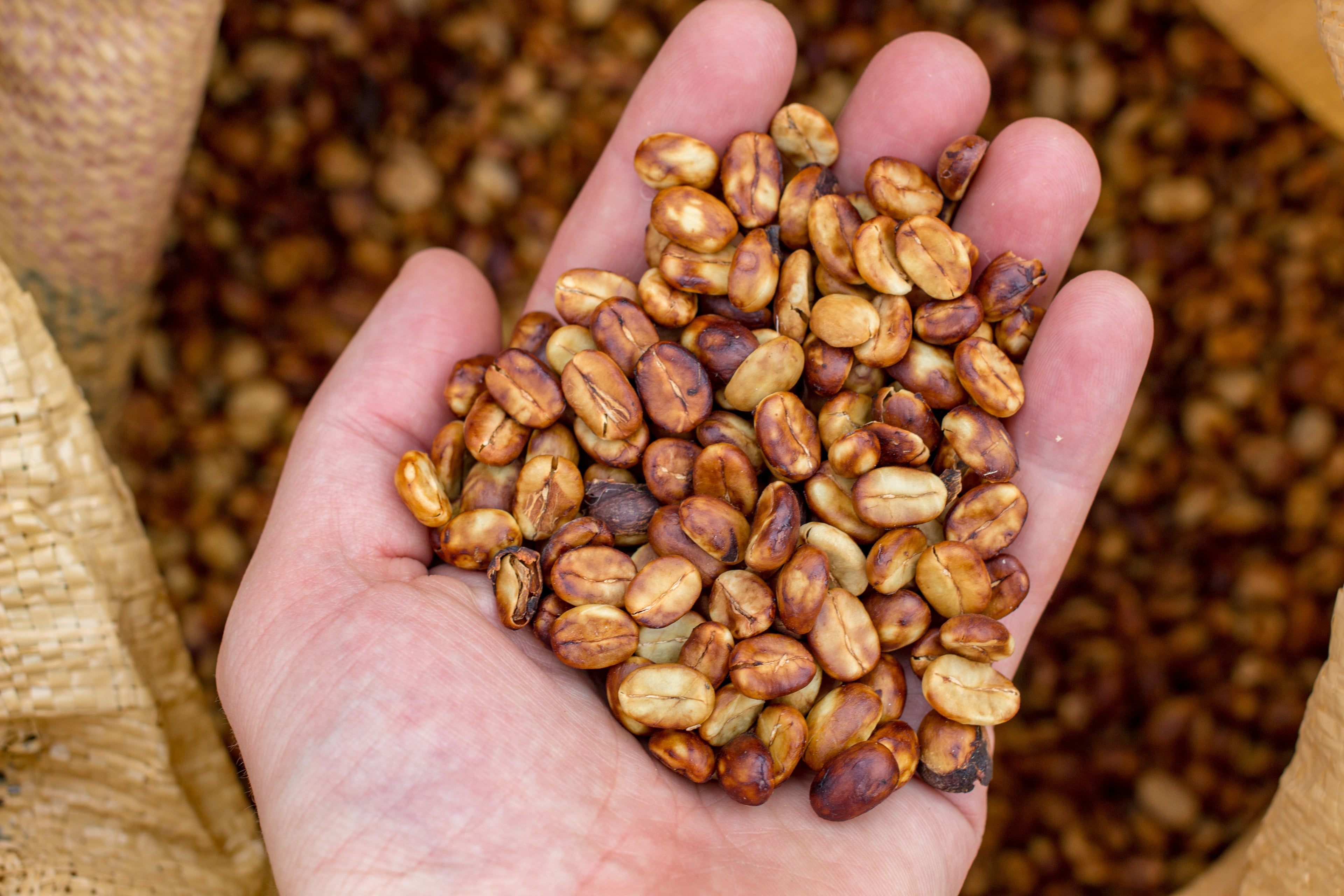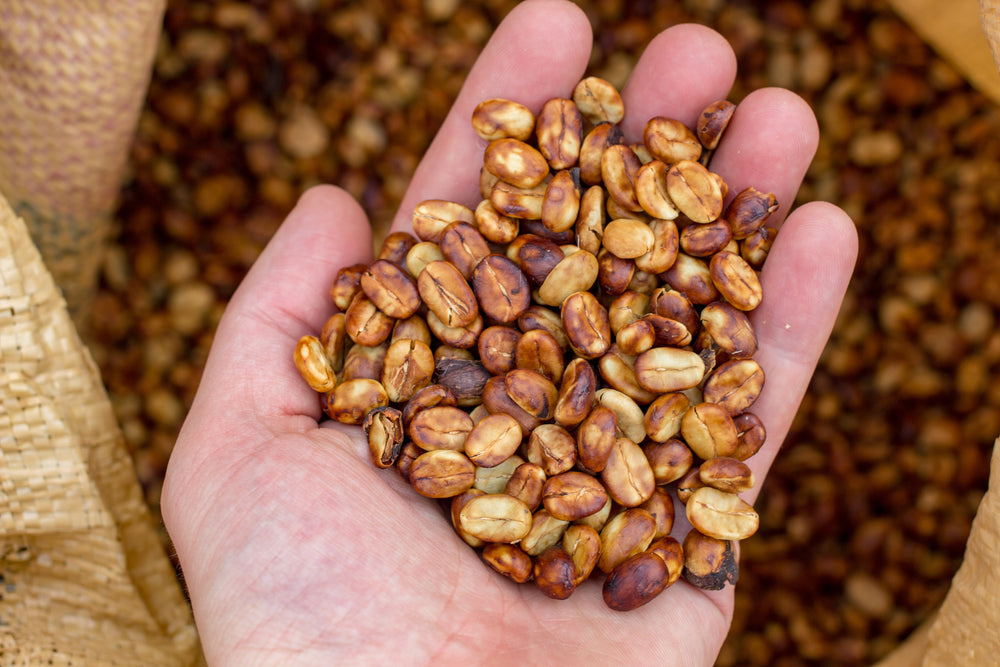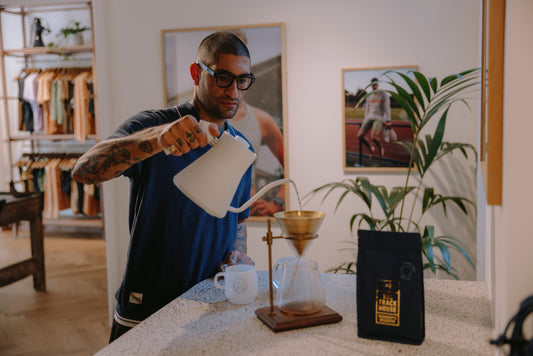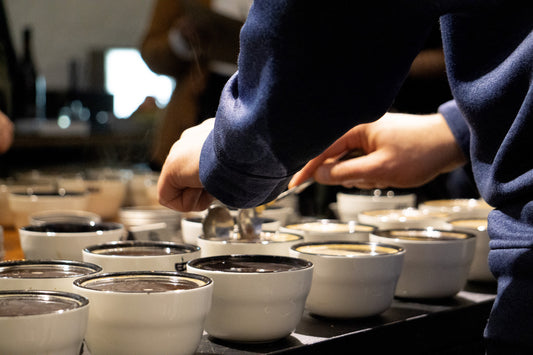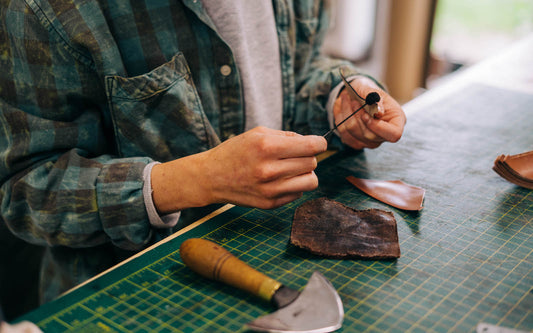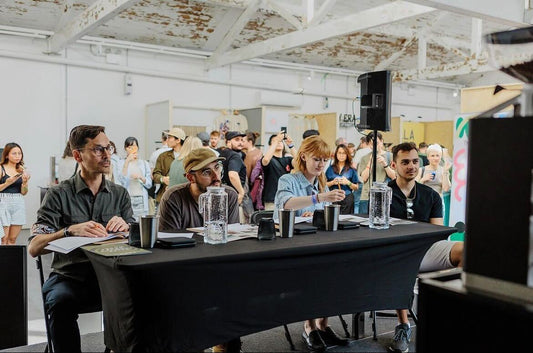COFFEE MISNOMERS:
We all call the suspended foam and emulsified oils on top of an espresso “Crema”, but we’re also aware that it isn’t actually “Cream”. A potentially misleading coffee term in the same vein is “Honey Processing”, whereby some of our customers have mistakenly assumed that actual honey is added during the processing stages. Just like “Crema” refers more to the creaminess of espresso, “Honey” refers to the honey-like stickiness created during the drying process of honey coffees. Here, we hope to explain the term "Honey" and give you a glimpse of some of our upcoming coffees produced using a Honey Process.
COFFEE CHERRIES:
A ripe coffee cherry has several protective layers surrounding its seeds, of which there are usually two, but sometimes one (a Peaberry), sometimes three, and in super rare cases, seven.* Under the tough outer skin, a slippery, sticky flesh layer that is sweet and delicious, adheres firmly to the parchment, the thin papery jacket which surrounds the green coffee seeds. With enough pressure employed to the outside of a ripe coffee cherry, the seeds, still encased in their parchment, pop out thanks to the lubricating nature of the coffee’s sugary mucilage.

Diagram showing the different layers of a typical coffee cherry, taken from Wintgens' publication: "Coffee: Growing, Processing, Sustainable Production."
Manually pulping a ripe coffee cherry in slow-motion, whilst enjoying a cold beer on Finca San Francisco, El Salvador.

Red and Yellow Catuaí coffee cherries, growing on La Pastora, Costa Rica.

On the left, a Catuaí cherry, on the right a Pacamara cherry, at Finca Santa Teresa, Costa Rica.

*A polysperma coffee cherry, containing seven seeds, from Gilberto's variety garden at Los Pirineos, El Salvador.
DRYING COFFEE SEEDS:
To take coffee cherries to dried coffee seeds, a producer can choose many different routes to get there. The option they prefer depends on many different factors including, but not limited to, regional traditions, equipment, availability of space, the quantity of fruit, labour costs, the availability of water and outside influence from their buyers.
Drying coffee to stable, exportable moisture levels can be done under direct sunlight or various degrees of shade netting. It can be exposed for 24 hours a day or covered during certain particularly sunny periods of the day and the more humid, cool conditions overnight. It can be placed directly on the ground, on plastic tarps, on poured concrete patios or mesh-slung raised beds. Alternatively, instead of utilising sunlight, or if it is not sufficient due to climatic or other logistical reasons, a mechanical dryer can be used, which can be thought of as an oversized tumble dryer.

Roger Ureña's recently covered drying patios, with gaps for ventilation and to let wind run through, Santa Teresa 2000, Costa Rica.

Lower grade honeys being dried quickly on black plastic tarps, El Salvador.

Washed coffee being turned and sorted at Hunkute station, Ethiopia.

Jacob Montero checking the moisture content of parchment coffee drying on raised beds at Beneficio Don Eli, Costa Rica.
Drying is the best chance to lock in a coffee’s innate flavour, which is dictated by the variety, terroir, climate, harvesting and processing of the seeds before we modify that flavour in roasting and brewing techniques. Linked to coffee quality, drying is effectively ‘preserving’ a coffee’s flavour, massively impacting how long it will taste fresh. The more controlled, uniform and gentle the drying is, the less likely it is that cell damage occurs when it loses moisture and if the parchment layer is kept intact, then it is less likely the green seeds are exposed to the elements or off odours. Once the seeds are dried down inside their parchment layer (unless you are talking about the traditional Indonesian process of Wet Hulling or Giling Basah) they need to be milled to remove the parchment before the green coffee is graded visually, by size and by density.
Before we get to the drying stage, however, there are various ways to ‘process’ or ‘prepare’ the coffee, which alter how the coffee dries logistically and alter the organoleptic characteristics in the final. So, let’s look at a few ways the coffee can be prepared for drying in different ways; what sorts of coffee processing are there...?
NATURAL PROCESS: DRYING COFFEE CHERRIES:
The most rugged, lo-fi and straightforward way to dry coffee is to dry the cherries intact, on the ground, under direct sunlight. A very basic dry or natural process, sometimes referred to as ‘home processing’, is reserved for off grades that smallholder farmers may use to prepare their rejected coffee cherries. It can take a long time as there is moisture in the fruit’s skin and mucilage as well as the seed which needs to evaporate and leave the fruit plus there's an elevated risk of the skin piercing and mould forming. Compounded by the longer time it takes to dry coffee cherries naturally, it's common for rotten and acetic flavours to develop as microbiota digest the copious amounts of sugar, oxygen and moisture available. Bypassing all coffee processing equipment also means eschewing certain physical aspects and designs commonly built into a processing station which compartmentalise coffee cherries by density, e.g. reception tanks for flotation, grading channels, cribas, etc.

Whole cherries drying on patios, being raked and turned over in the midday sun, El Salvador.
However, it isn’t all funky, off-flavours in the world of naturals. Many producers create good quality naturals by first washing the fruit, removing floaters, taking care to create the right depth in their layers, using raised beds for proper airflow and employing teams to turn and sort through the coffee frequently and carefully. All of these steps are undertaken to create the pungency, body and intensity associated with naturals, without introducing overriding, defective flavours.

Santos at El Hato checking on his natural experiments, Guatemala. By washing the fruit before it is put onto the beds there is a decreased risk of mould growing on the fruit surface.
DEPULPING COFFEE CHERRIES:
Naturals are in a class of their own. All other coffee processing methods then share something in common; the cherries undergo depulping whereby removing some to all of the fruit layers from the parchment coffee, you have less collective moisture to remove during drying. Removing the coffee cherry skins is relatively easy, and there are a wide variety of depulping machines that are employed. Some mechanisms use ridged disks, and some are more like a mangle or roller mill. They come in all sorts of sizes with some fed cherries in a stream of water, others merely using gravity, powered by anything from diesel engines, electricity, hand-cranks or even by bike.

One of JASAL's trusty Jotagallo depulpers at the Las Cruces mill, El Salvador.

The traditional disc pulped used at Jarama station to process coffees from the Kivu Belt Group's farms, Rwanda.

Celeste showing us the processing equipment at Nyarusiza station, Rwanda.
Before depulping can begin, they are first calibrated, set like a coffee grinder to a specific width between the grinding plates or surfaces. If set correctly they squeeze fully mature, ripe coffee cherries with just enough force to extrude the seeds without bruising or nicking them. Set too close together, however, allows smaller, semi-ripe cherries to be depulped, while the desired large, ripe seeds could be damaged.

Reception tank, depulper and criba at Apolo 11, Nicaragua.

A wonderfully creative pedal-powered depulper at Finca La Pila, installed by Rodolfo Garcia, Guatemala.

Mario Jiminez's depulped coffee at Beneficio La Angostura, Costa Rica.
‘WET’ WASHED PROCESS USING NATURAL FERMENTATION:
After depulping the day’s harvest, a coffee producer now has an entire batch of slippery, fruit-covered seeds ready for the next step. Most opt to naturally ferment the coffee, whereby microbiota (bacterias, yeasts, fungi) on the fruit and in the air, begin to eat the sugars and pectins in the fruit mucilage.

Washed processing (Lavado) at Las Cruces mill, El Salvador.

Gilberto checking out the remaining mucilage on his parchment before it undergoes wet fermentation at Los Pirineos, El Salvador.

Dry fermentation tanks at Finca El Guatalon, Guatemala. Note how vigorous the fermentation is, fizzing and foaming away.

A criba and dry fermentation tanks at Finca El Mirador, Guatemala, where we buy their Los Altares preparation.

'Aguamiel' or honey water, with a dark reddish hue, that gains sugars and acids as it is recycled to sluice coffee from the depulpers to the fermentation tanks at Las Cruces, El Salvador.
Fermentation can be done by submerging the coffee underwater in a tank (known as wet fermentation, also erroneously referred to as anaerobic fermentation) or simply in a tank, perhaps covered with a tarp, (known as dry fermentation). In both cases, the temperature and presence of sugars and micro-organisms all affect the rate at which fermentation takes place. The primary goal for the producer is to start breaking down the sticky sugars from the parchment layer to ease turning and drying the coffee, but there are growing arguments that natural fermentation at this stage has a significant impact on flavour development. There are many papers written on experiments performed around fermentation in coffee processing; some are introducing cultivated strains of yeasts, whilst others add external sources of sugar with things like sour, cultured milk or fermented rice to alter the direction and type of fermentation occurring.

Washing channels where workers use a 'sandal' to scrub the broken down mucilage off of the seeds, Nyarusiza station, Rwanda.

Washing channels at Cerro de Jesus, Nicaragua.

Workers at Umurage station, Rwanda, shuffling through the fermented coffee to remove the bulk of mucilage before it is run through washing and grading channels.
After the dry or wet fermentation stage is deemed complete, the broken down sugars are washed off of the seeds by adding water and scrubbing the batch of coffee. Often done in concrete channels, there is a chance to place wooden boards that sit halfway up the channels to trap the more dense coffee, allowing the less dense seeds wash over the top enabling the producer to refine and compartmentalise their coffee into different quality tiers. In Kenya, Ethiopia and some regions in Rwanda there is often another stage of soaking the washed coffee in clean water, a protocol that is gaining popularity in other countries as well to homogenise the moisture in the batch and allow any residual sugars another chance to break down and be removed from the parchment layers. A process described as 'Washed' refers to one of the least interesting parts of the process; it merely infers to the use of water and turbulence of coffee being sluiced through the processing equipment to remove the broken down mucilage. Once fermented the pectins are broken down and the mucilage can now be hydrolysed and physically removed from the parchment.
It is typically at this point when the processing water becomes laden with sugars, sometimes referred to as ‘Aguamiel’ or ‘Honey Water’. Requiring treatment to clean and filter this water before being released into the water table requires more space, labour and time, proper techniques, availability of knowledge and the right materials to do so. It is fair to say that even though the product of naturally fermenting coffee before drying may well save time on drying patios or beds, it requires much more attention and carries risks of imparting off flavours.

A less than ideal set up in Guatemala, with a dirty pulper and untiled fermentation tank.
Over the years we’ve tasted many coffee samples from Guatemala and Colombia which taste strongly of rotting coffee pulp, suggestive of overfermentation. Vinegar like flavours can occur when the fermentation is too aggressive, and if it is carried on for too long, we have sometimes noticed a metallic, rough edge to the cup. There is also the risk of the rate of fermentation being inadequate and if the organisms responsible for the fermentation are ‘starved’ there can be an increase in Butyric acid or Propionic acid, creating cheesy, rancid butter-like flavours.
‘MECHANICAL’ WASHED PROCESS USING DEMUCILAGINATORS:
There is another way to produce 'washed' coffees without the pitfalls of inadequate fermentation and heavy water usage. This alternative way to remove coffee’s mucilage layer after depulping is to bypass fermentation in favour of machinery that uses friction to scrape off the sugary layers effectively. A typical modern beneficio in a country very conscious of water usage and contamination like Costa Rica may be fitted out with an Eco-Pulper and Demucilaginator*; machinery that can depulp and demucilage coffee cherries avoiding the need to ferment the coffee. This machinery significantly reduces labour costs, even though they do need extra attention to calibrate and keep clean, and leads to more consistency between batches. Some coffees from El Salvador and Costa Rica are called “Washed” when they haven’t seen any water during processing. There are those who then employ a soaking stage after using a demucilaginator, which may be called 'Doble Lavado' or 'Double Washed' and is meant to mimic the African method mentioned earlier.

Inside a vertical demucilaginator at Los Pirineos, El Salvador.

The slurry coming out of the bottom of this cylindrical demucilaginator at Los Pirineos, El Salvador, is essentially a thick, coffee-fruit puree. The skins are funnelled into a compost heap to break down and repurposed as fertiliser for the coffee trees.

The processing set-up at Santa Teresa 2000, Costa Rica uses gravity to take coffee cherries down through a depulper and then a demucilaginator before being dried as 'white honey' lots on either patios or raised beds.
There are arguments on either side, but lots of producers and consumers believe that bypassing natural fermentation reduces the development of specific flavour compounds. We’re able to taste when coffee has been over-fermented at this stage, so there’s a strong argument that something is happening to alter the coffee’s flavour when it is naturally fermented, but we would also agree that mechanically washed coffee can also be complex and delicious.

'Demucilaginator' would make a great name for a Black Metal band. Their killer album would naturally be named 'Remover of Flesh'
HONEY PROCESSING:
When you employ either natural fermentation or use of machinery to remove the mucilage from depulped coffee, it becomes very clear-cut when the ‘processing’ stage finishes and when the ‘drying’ stage begins. With naturals and honeys, however, the two stages bleed together.
Honey processing describes the process of drying coffee with anything from a small amount to the entirety of the coffee’s mucilage left on the parchment layer surrounding the seeds.

Separate beds for separate processes at Finca La Pila, Guatemala. Where Rodolfo Garcia lives in Santa Ana La Montaña water is scarce, so he goes against the grain of typical Guatemalan processing and does almost exclusively honeys and naturals.

Beautiful, clean, thin and even layers of freshly depulped coffee which darken as it dries, Finca La Pila, Guatemala.
The mucilage on the coffee parchment typically discolours as it dries. Several factors alter how deep the colour turns, and also how sticky and clumpy the drying coffee becomes. Using merely a disc pulper versus running the depulped coffee through a demucilaginator results in a very different amount of mucilage on the seeds. Calibrating the mechanical washer to remove a certain percentage of mucilage allows those with this equipment to dictate how much sugar to keep on the seeds. This, as well as the depth of layers the coffee drys in, the temperature, the humidity and how vigorously and frequently the drying coffee is turned, all impact how dark the honey gets. By design, or by accident, producers can then market their different honey preparations as anything from ‘White Honey’, through ‘Yellow’, ‘Gold’, ‘Red’ and ‘Black Honey’. We have even seen one producer experiment with honeys whereby they perform the same depulping and drying protocols but affect the colour on the parchment from deep yellow to rusty red by keeping the cherry in a tank for 24 hours versus 48 hours before depulping, effectively macerating and beginning fermentation before they even reach the depulping stage.

Many raised beds offering various hues of honey processed coffees at Los Pirineos, El Salvador.
 Coffee cherries held for 48 hours prior to depulping created this 'red honey' lot at Finca El Mirador, Guatemala.
Coffee cherries held for 48 hours prior to depulping created this 'red honey' lot at Finca El Mirador, Guatemala.

Coffee cherries held for 24 hours prior to pulping created this 'yellow honey' lot at Finca EL Mirador, Guatemala.

Contrasting the parchment from a washed and soaked lot versus a red honey lot at Finca El Mirador, Guatemala.
Other countries may describe a honey process as a ‘pulped natural’ or ‘semi-washed’ coffee, which are also processes which involve taking the skin off but leaving the fruit sugars on the seed for drying.

Freshly depulped coffee taken in sacks to drying beds at Los Pirineos, El Salvador.

Turning continually avoids the coffee clumping together which can result in uneven fermentation and potentially creating off flavours, Los Pirineos, El Salvador.

Arleen Jiminez spreading out mucilage covered coffee parchment to dry as a honey, Beneficio La Angostura, Costa Rica.
The pitfalls of honeys are that they require labour, care, time and attention, just like naturals for them to be great. They can over-ferment easily as sugars exposed to the elements and microbiota in the environment, in layers that are too deep or not turned frequently enough lead to inconsistencies in the batch of coffee. However, if a producer has space, the labour, expertise and the willingness to experiment, honey processing can enable them to diversify the range of coffees they produce, amplify specific positive flavour attributes like sweetness and body, and reduce their water usage massively.

John Mark's crazy experiment to 'hotbox' mucilage covered seeds in these beehive structures, and increase the fermentation rate to create a more significant flavour impact, Finca Apolo 11, Nicaragua.

What happens when you aren't turning your honeys enough.
FIVE FEATURED HONEY COFFEES:
Why might a producer opt to do honey processing? We want to highlight five upcoming coffees we'll be roasting this year, to show just how the techniques and reasoning behind honey processing differ amongst producers.
Santa Rita Vivero, El Salvador
Our longstanding partners at JASAL usually supply us with coffees from their vast estate, Finca San Francisco in Santa Ana. We decided to explore another of their farm's, Finca Santa Rita Vivero, after tasting a honey processed lot of Catimor. It surprised us as Catimor tends to produce a poor cup, with astringency and bitterness, without much complexity. Their Catimor trees are not resistant to rust, but tolerant, and when rust spots begin forming the plant fights back, limiting the spread of the disease. The particular strain they're tending to is Catimor 5175, an improved line from Costa Rica, that was planted on the farm 35 years ago, giving the Salaverria family plenty of time to learn how best to prune, pick and process the cherries to maximise the flavour potential. They pick it incredibly ripe, almost beyond purple into a brownish red, and depulp them using their Jotagallo machines. As much mucilage as possible is left on the parchment before drying on raised beds. If you're wary of resistant varieties coming from Timor Hybrids, this may well be the coffee that changes your mind about their role in specialty coffee.

Jose Antonio Senior, cruising around in the dusty volcanic soils of Finca San Francisco.
Viuda, Costa Rica
Last year we bought a small lot from Roger Ureña, grown on his "El Cedral" plot near the Santa Teresa 2000 micromill in Santa Maria, Tarrazú, Costa Rica. We revisited him this year and scoped out some of his other farms and plots. The lot we've purchased this year was grown on "Viuda", but is comprised of the same variety, Red Catuaí, and is also a 'White Honey' lot. For him this means it is mechanically washed, removing most of the mucilage, before being dried on raised beds in his covered greenhouse. Roger processes all his coffees this way to reduce his water usage and is part of the Bandera Azul certification scheme gaining carbon neutral certification last year. None of the coffee ferments after depulping, however, he does hold harvested cherry in a small wooden silo overnight prior to processing, so there may be some added complexity in the cup from this stage.

Roger Ureña cupping a sample of white honey processed coffee at Santa Teresa 2000, Costa Rica.
Qore, Ethiopia
Yirgacheffe, like a lot of Ethiopia, traditionally produces just naturals and washed coffees. The way that coffee has been traded and marketed in Ethiopia is very rigid, but things are changing. Privately owned washing stations are beginning to experiment, and Israel Degfa, from whom we purchased several coffees last year, has begun to produce honeys at his Qore station. Comprised of native Typica Hybrids, Certo and Wolisho varieties, his coffees from Qore are typically very floral and delicate. Being the first time we've tried an Ethiopian honey, the processing has amplified the sweetness and body of the coffee.
Israel Degfa in the cupping lab, Ethiopia.
Rodolfo Garcia, Guatemala
In Santa Ana La Montaña agua trucks roll by once a day to sell water to families without a municipal water supply. Rodolfo Garcia and his family at Finca La Pila have designed their processing station around the fact that water is scarce and expensive, and he has a small set-up built to dry tiny lots of honeys and naturals on raised beds under cover. The honeys are depulped by a bicycle-powered mill, making for a very lo-fi setup without running water or electricity. All of our other coffees from Guatemala come from the Huehuetenango region and are all dry fermented and washed. It was the first time this year that we tasted honey processed lots from Guatemala that were delicious and not just funky and unbalanced. What is exciting is that Rodolfo has corralled his neighbours into a scheme to sell their coffee cherries to Primavera to create high quality, bulked lots from the neighbourhood processed in a more typical manner at El Hato, Christian Rasch's farm near Guatemala City. We have a small lot of Rodolfo's honey process to release as a filter coffee, and also a larger lot from him and his neighbours which will run as an espresso later this year under the name "Rodolfo Garcia & Friends".

Rodolfo Garcia holding a presentation for his neighbours about the importance of ripe cherry selection, Guatemala.
El Martillo SL28, El Salvador
You may remember the limited lots of SL28 we bought last year from the El Martillo plot on Finca San Francisco. Half of the cherries from the trees' first year of proper yielding were processed as washed coffee, and half as red honey. We purchased the entire production and sold it as a twin pack. When we fed back to the Salaverria brothers, we let them know just how amazing the red honey lot was. Although slightly trickier to roast, the flavours in the cup were intense and concentrated, in a way the washed wasn't. Our staff and customers alike preferred the honey processed lot, so this year the entire production is being processed as a honey. They spread the depulped coffee out in relatively thin layers on raised beds, and during cooler times in the morning or evening, they cover the beds with coffee sacks so as not to stall the drying. This may also promote more discolouration of the mucilage, meaning they call it 'red' or 'black' honey.

The Salaverrias, El Salvador.
Share:


